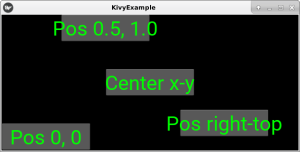This is an old revision of the document!
Appunti Kivy
This is the kivyexample.py file:
#!/usr/bin/env python from kivy.app import App #kivy.require("1.8.0") from kivy.uix.floatlayout import FloatLayout class MyLayout(FloatLayout): pass class KivyExampleApp(App): def build(self): return MyLayout() if __name__ == "__main__": KivyExampleApp().run()
In the code above we derived a class named KivyExampleApp from the Kivy's App class. The Kivy code will automatically search for a file called kivyexample.kv, and it will parse it using the KV language. The name of the file is derived by the class name, making it all lowercase and removing the leftmost App part (if it exists). So this is the kivyexample.kv file:
<MyButton@Button>:
font_size: 40
color: 0,1,0,1
size_hint: 0.3, 0.2
<MyLayout>:
MyButton:
text: "Pos 0, 0"
pos_hint: {'x': 0, 'y': 0}
MyButton:
text: "Center x-y"
pos_hint: {'center_x': 0.5, 'center_y': 0.5}
MyButton:
text: "Pos right-top"
pos_hint: {'right': 0.9, 'top': 0.3}
MyButton:
text: "Pos 0.5, 1.0"
pos_hint: {'right': 0.5, 'top': 1.0}
In the Python code, the App constructor will return the MyLayout class, which is derived from the Kivy's FloatLayout class. The original class is an empty widget, but we added several buttons using the KV language.
Notice that MyLayout is derived from FloatLayout declaring it into the Python code, whereas the MyButton class is derived from the original Button class using the KV language, via the @Button construct. The result should be something like this:

